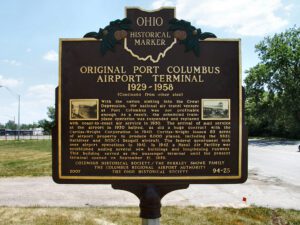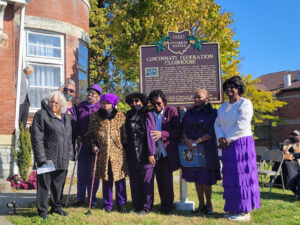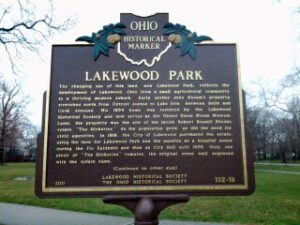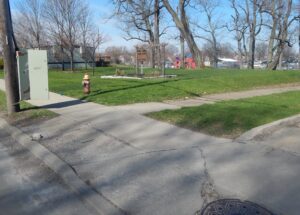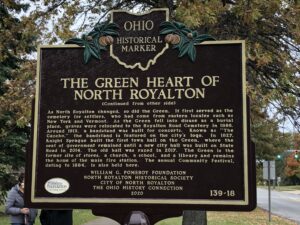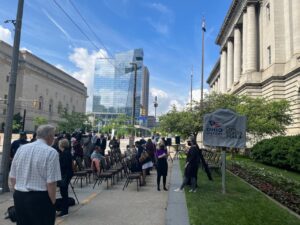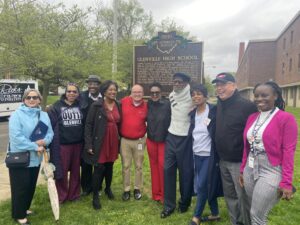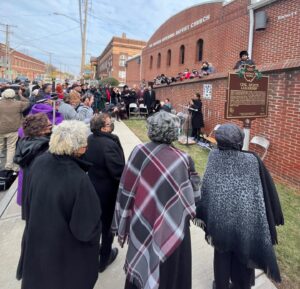, OH
The original Port Columbus Airport terminal was founded by the people of Columbus and was one of the first airport facilities in the United States. Dedicated on July 8, 1929, Port Columbus was the first transfer point in the westbound transcontinental passenger service, which was operated by the Pennsylvania Railroad, Transcontinental Air Transport (TAT), and the Santa Fe Railway. Its first passengers departed by rail from New York City on July 7, 1929, and boarded TAT Ford Tri-Motor aircraft at Port Columbus to fly to Waynoka, Oklahoma, the following day. They then traveled by rail to Clovis, New Mexico, and completed their journey with a TAT flight to Los Angeles. The scheduled 48-hour trip was celebrated in Columbus, marking the beginning milestone of national airport travel. (continued on other side)
, OH
“Lifting As We Climb”: The Cincinnati Federation of Colored Women’s Clubs (CFCWC) was organized May 6, 1904, during a meeting called by Mary Fletcher Ross at the Allen Temple A.M.E. Church. Gathering together eight existing African-American women’s clubs, the CFCWC sought to unite in their work promoting “the betterment of the community.” At a time when both government and private philanthropies overlooked the needs of Black Americans, CFCWC members helped to organize the city’s first kindergartens for Black children, taught in Cincinnati African-American public schools –including the Walnut Hills Douglass and Stowe schools—and raised money for the Home of Aged Colored Women. Since 1904, the Cincinnati Federation of Colored Women’s Clubs has ensured the civic and constitutional rights of all African Americans while meeting the needs of their city.
, OH
The changing use of this land, now Lakewood Park, reflects the development of Lakewood, Ohio from a small agricultural community to a thriving modern suburb. Early settler John Honam’s property stretched north from Detroit Avenue to Lake Erie, between Belle and Cook Avenues. His 1834 home was restored by the Lakewood Historical Society and now serves as the Oldest Stone House Museum. Later, the property was the site of the lavish Robert Russell Rhodes estate, “The Hickories.” As the population grew, so did the need for civic amenities. In 1919, the City of Lakewood purchased the estate, using the land for Lakewood Park and the mansion as a hospital annex during the Flu Epidemic and then as City Hall until 1959. Only one piece of “The Hickories” remains; the original stone wall engraved with the estate name.
, OH
By 1922, the Ambler Realty Company of Cleveland owned this site along with 68 acres of land between Euclid Avenue and the Nickel Plate rail line. Upon learning of the company’s plans for industrial development, the Euclid Village Council enacted a zoning code based on New York City’ building restrictions. Represented by Newton D. Baker, former Cleveland mayor and U.S. Secretary of War under Woodrow Wilson, Ambler sued the village claiming a loss of property value. In 1926, the U.S. Supreme Court ruled in favor of Euclid and upheld the constitutionality of zoning and land-use regulations by local governments. The federal government eventually acquired the Ambler site during World War II to build a factory to make aircraft engines and landing gear. From 1948 to 1992, the site was used as a production facility by the Fisher Body Division of General Motors.
, OH
Bounded by Ridge, Royalton, and Bennett Roads, the Green has been the heart of North Royalton even before it was incorporated. Once part of Brecksville Township, Royalton became its own township in 1818. Local lore says that settlers David and Knight Sprague paid a gallon of whiskey to name the community after their hometown of Royalton, Vermont. In 1825, John Watkins sold five acres to create this Green, so that the township could have a cemetery, a public square, and a place for public buildings. In 1885, “North” was added to “Royalton” to distinguish it from another Royalton in Ohio. Formerly a small agricultural community known for milk and cheese production, as well as nurseries, North Royalton became a Cleveland suburb following World War II. North Royalton incorporated as a village in 1927 and became city in 1961. (Continued on other side)
, OH
Carl Stokes was born in Cleveland on June 21, 1927. Recognized for his trailblazing service as a public official, Stokes is one of the few American politicians whose career spanned all three branches of state government. Over 30 years, he served 3 terms as an Ohio legislator (1963-1967), 2 terms as Cleveland’s mayor (1967-1971), and 8 years as a municipal court judge (1983-1994). In 1972, he became the first Black anchorman for a television station in New York City. After a decade working in television, Stokes returned to Cleveland to work as an attorney for the United Auto Workers. In 1994, President Bill Clinton appointed him U.S. Ambassador to the Republic of Seychelles. While serving as Ambassador, he was diagnosed with cancer. Carl Stokes died, in Cleveland, on April 3, 1996.
, OH
Invited to speak at three Cleveland high schools, Dr. Martin Luther King Jr. delivered his powerful “Rise Up!” speech to students at Glenville High School on April 26, 1967. It signaled King’s opening drive to elect African Americans to prominent government positions in northern cities. Encouraging students to “develop a sense of somebodiness,” King challenged them to “work passionately and unrelentingly for first-class citizenship.” Recognizing the fear of racial unrest in the city, King underscored the significance of nonviolence. “Our power lies in our ability to say non-violently that we’re not going to take it any longer,” he asserted. Making Carl Stokes’ mayoral bid the focus of his push for Black voters to elect Black leaders, King urged Glenville’s students to join civil rights organizations and community action programs.
, OH
The Greater Abyssinia Baptist Church (GABC) organized with 250 members on December 16, 1945, at a Phillis Wheatley Association meeting. Led by its first pastor, Rev. John Rollins Plummer, the congregation raised $47,000 to purchase the Jewish Synagogue at East 105th Street and Tacoma Avenue from the Beth Hamedrosh Hagodel Beth Israel Congregation in 1946. It later purchased a parsonage, land for parking, and created a Federal Credit Union. Tragically, Rev. Plummer was killed in a car accident on October 22, 1951. The church’s lower auditorium was remodeled and dedicated as J.R. Plummer Memorial Hall. Honoring its missionary and pastoral care foundations, the church built a $3M senior citizens complex nearby. An endowment fund, instituted by its pastor’s savings in 1995, ensures that this commitment to civic leadership endures.


